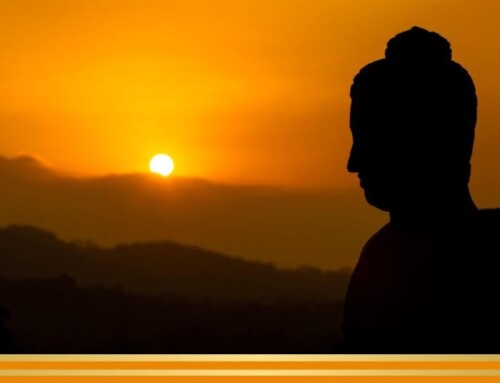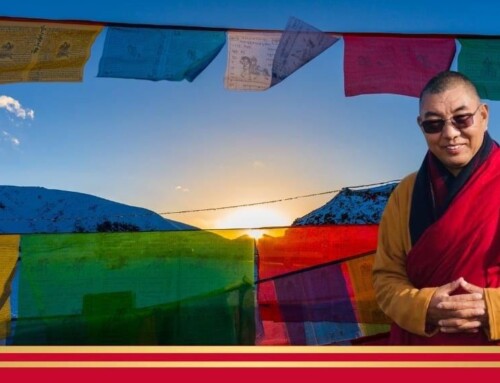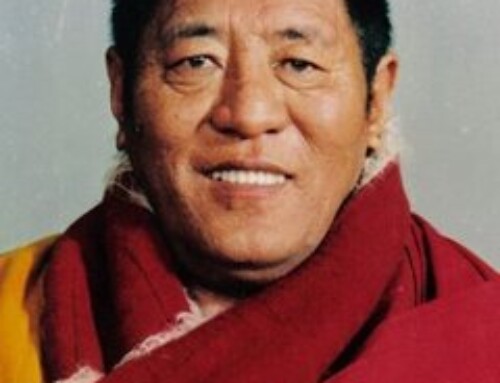My root guru always said to me that it is very simple to meditate on our minds. The reason he explained is because everyone has a mind, the one who guides the mind to meditation is the self, and the very mind to bring to meditation is also that of self. Therefore, it is one’s own mind that guides the delusional mind to a perfect one.
When my root guru and I meditated together, he would look at me and say, “Where are you now Lama?” Even though I sat right in front of him, he would look at me directly and repeat it several times. He meant to ask me if my mind was really in my body. On a daily basis he would say to me that he could see my body in the temple but he hoped that my mind was in my body. For the mind to be in the body and for that mind to be free from all the delusions are quintessential instructions that I consider of utmost importance and analyze every day of my life. So the word “mindfulness” in English is related to this. For instance, in Tibetan, we say “mayeng” (be undistracted) which is connected to mindfulness. Our everyday habits must be anchored by this mindfulness.
A beginner starts to meditate and determines that he will not let his mind wander or has great hopes for a good session. Then when the meditation session does not go well, there is great discontent and doubt. The thoughts that the meditation did not go well yesterday and today, all arise hope and doubt. This continuous hope and doubt has led us to the unending cyclic existence. Gag (stop the unwanted) and Drup (hope for the good) and this endless hope and doubt have kept us in the samsara until now. When meditating, if your mind constantly waxes and wanes between hope and doubt, it is not beneficial. It is very important to keep the mind as is. Whatever thoughts arise in the moment, let it arise, whatever it may be. Thoughts cannot be stopped and should not be stopped. Thoughts are countless. If one ponders on every thought, one thought will lead to another and to another, and one could become mentally unstable. The vital instruction is to be undistracted and be aware. Whether thoughts arise or not, if the mind is aware, this harness of awareness, is called meditation.
During a snowfall, when snow falls from the sky, it is just snow but the moment it falls onto a hot rock, it is no more snow, the form has changed from snow to liquid. Likewise, when the mind is not aware, we call it thoughts but once our consciousness is harnessed by awareness, we do not call it “thoughts”. Thoughts are released into Dharmakaya. When in awareness, the rise and release of thoughts occur simultaneously. In other words, thoughts do not have any effect on our minds. The most important thing during meditation is to be aware and mindful. One cannot meditate without mindfulness.
When beginning to meditate, it is very important to do so in short but frequent sessions. If you sit for five minutes today, sit for ten minutes tomorrow. Don’t bother about the length of a session that you sat for one hour, two hours, or one day, but rather, while in meditation, be aware of the lucidity and clarity of mind with the grasp of mindfulness over thoughts. With the instant release of all thoughts that arise into Dharmakaya, rest your mind in the clarity of Rigpa.
For many, meditation may mean only stopping the six senses. Many think that by merely blocking the sense of sight, sound, speech, smell, and touch, they have meditated well. This is a good experience for a beginner, but meditation is beyond that. When one meditates, one experiences a profound sense of joy and bliss from the depths of one’s mind, without any effort. The reason why this happens is because as thoughts release into Dharmakaya, the strength of that Dharmakaya or Rigpa manifests itself as extraordinary joy and bliss. At that moment, one develops an immense devotion towards one’s root guru and great compassion towards all sentient beings as tears begin to flow from one’s eyes. In this experience, one develops the wish to meditate more. If one has meditated for an hour, one wants to continue for two hours and does not wish to part from one’s meditation cushion. One develops a very deep and keen interest in meditation. As Buddha himself experienced and said, “Profound peace, free of fabrication, unborn clear light!I have found a Dharma that is like nectar! If I reveal it to anyone however, they won’t understand so I should just stay in the forest! Profundity, peace, freedom from fabrication, being unproduced, these are all characteristics of emptiness. When one experiences the qualities of emptiness, one develops conviction in it, an appreciation for it from the depths of one’s heart and develops a single pointed devotion towards it. We should all strive for that.
Regarding the stages of meditation, I usually talk about, “Tayatha Gate Gate Para Gate Para Sam Gate Bodhi So Ha”. “Tayatha” refers to all sentient beings. “Gate Gate Para Gate Para Sam Gate Bodhi So Ha ” are the five paths, the paths of accumulation, preparation, seeing, meditation, and no more training. (In Tibetan, tsoklam, jorlam, thonglam, gomlam, and milopa lam). Through the path of meditation, one can reach the path of no more training. milopa. At “Gate”, during great tsoklam, path of accumulation, an individual with ripe karma & fortune recognizes emptiness. Emptiness recognized at this stage is likened to the size of the moon on the third day of the month. We can only see a small moon but one has still seen it and thus is able to say that one saw the moon. At this stage, you can say that you have recognized emptiness. “Gate Para Gate” is a stage of development or perfection of one’s experience and equated to the size of the moon as it becomes larger from day three to day fifteen, on the full moon day. “Bodhi So Ha” is the ultimate stage our mind can reach. In Tibetan, it is called the “Mi nae pa nyang dae”, the non-abiding nirvana. So one can ultimately develop the perfect mind and make strides at each stage at a time to arrive at the final stage.
My greatest aspiration in this lifetime is to develop this mind. In Dharma, there is the path to fruition of the stages and an opportunity to develop our mind, and so, I tell my students of this deep aspiration. As a spiritual guide, I teach the dharma in its most genuine form, however, some of you may be sad being unable to practice it diligently and think that that may cause me sadness. I would like to say that each one of your individual circumstances is different, including, temperament, time, family, other commitments and so forth, so if you have felt so, there is no need to be sad. However, as we all know, we must hope for the best. As we are fortunate to have this precious human life with a precious human mind, it is important to make good use of it.
Whatever, I said above is intended for a dharma practitioner. Whether one believes to be a Buddhist or not, meditation helps to transform one’s mind from an afflictive state to a non-afflictive one. Even though one does not believe in rebirth and aspire to attain Buddhahood, we are currently in this human form, and having taken birth as a human, if we want to become a kind human being, one must make the transformation from within oneself. This transformation is not separate and cannot be externally borrowed or bought. To transform an afflictive mind to a non-afflictive one, must be brought about through one’s own mind. I speak about “good, better and best”. So, there is a path to the “best”.
In our lives, we are daunted with many challenges, both physical and mental. Physical adversities are easier to overcome. For instance, physical ailments can be treated with available medical facilities, but mental hardships can be overcome only by oneself, and very seldom by others. As Buddha said, “I have shown you the path of liberation. You must follow it in order to achieve it”, similarly, a spiritual teacher can only guide you towards the path, it is upon oneself to choose to follow and pursue the path. A lama cannot solely help you towards liberation, the main effort must come from you. So if you pursue your practice diligently, it will help you enormously on the day you are confronted with great adversity. If you practice diligently, one day you will realize emptiness. Emptiness is like a tree. Kindness, compassion, four immeasurables and six paramitas are like the branches, leaves and flowers of the tree. Once one develops emptiness, one’s mind will be undeterred even when confronted with the greatest hardship of one’s life. To develop the mind is like the ultimate security and protection for the mind. A good human being is not defined by one’s physical traits but rather one who is kind and compassionate, and if one is a dharma practitioner, who practices the four immeasurables and six paramitas. So, it is extremely important that we practice to develop our mind through meditation.
Originally posted on January 28, 2017, http://www.khenpokarten.org/2017/01/






